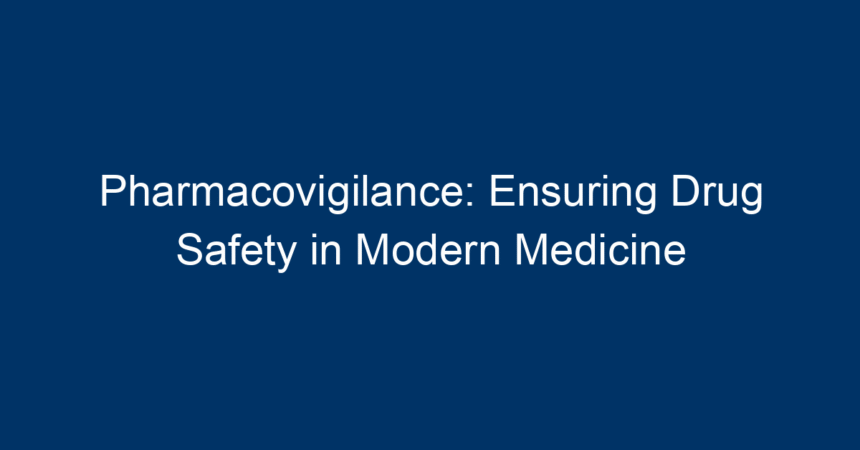In the complex world of modern medicine, the safety of pharmaceutical products is paramount. As new drugs are developed and introduced into the market at a rapid pace, ensuring their safety becomes a critical task. This is where pharmacovigilance plays a vital role. Defined as the science and activities related to the detection, assessment, understanding, and prevention of adverse effects or any other drug-related problems, pharmacovigilance is essential for maintaining public health welfare.
In this article, we will delve into the importance of pharmacovigilance, the processes involved, and what healthcare professionals and the public can do to foster a safer medical environment.
What is Pharmacovigilance?
Pharmacovigilance stems from the merging of two Latin roots: ‘pharmaco,’ meaning drug, and ‘vigilare,’ meaning to be vigilant or to keep watch. Essentially, it is the ongoing monitoring of drug safety to ensure they are used effectively and safely after their approval. One of the primary goals of pharmacovigilance is to detect adverse drug reactions (ADRs) that may not have been identified during clinical trials.
The Importance of Pharmacovigilance
-
Patient Safety: The foremost reason pharmacovigilance exists is to protect patients. By monitoring ADRs and other drug-related problems, healthcare providers can identify harmful effects and take necessary actions to mitigate risks.
-
Regulatory Compliance: Health authorities such as the FDA (U.S. Food and Drug Administration) and EMA (European Medicines Agency) require robust pharmacovigilance systems. Adhering to regulations not only protects patients but also enables pharmaceutical companies to avoid legal ramifications.
-
Improving Drug Efficacy: Insights gained from pharmacovigilance can aid in enhancing drug formulations, including dosage adjustments or combinations that enhance efficacy while reducing adverse effects.
- Public Awareness: Through effective pharmacovigilance, healthcare systems inform both healthcare professionals and the public about potential risks associated with medications, creating an informed community.
The Pharmacovigilance Process
Data Collection
The pharmacovigilance process begins with the collection of data related to drug safety. This data comes from various sources including:
- Clinical Trials: During the pre-marketing phase, data is collected on ADRs experienced by participants.
- Post-Marketing Surveillance: After a drug is released to the public, ongoing reporting of ADRs is vital. Patients, healthcare professionals, and pharmaceutical companies report any adverse reactions they observe.
- Literature Reviews: Published research papers and medical literature also contribute invaluable information regarding drug safety.
Data Analysis
Once collected, the next step is to analyze this data. Advanced statistical methods are applied to identify patterns or signals that may indicate a drug’s safety profile could be compromised.
- Signal Detection: A ‘signal’ is an indication that a drug may have a safety problem. Identifying these signals promptly is crucial for risk assessment.
- Causality Assessment: Understanding whether a drug is indeed the cause of an adverse event is a complex process that involves weighing multiple factors.
Risk Assessment and Management
Once signals are detected, a thorough risk assessment is performed. This involves evaluating the potential risks associated with a drug and weighing them against the benefits it provides.
- Risk Minimization Strategies: If a risk is confirmed, regulatory bodies advise pharmaceutical companies to develop strategies to minimize these risks, which might include revising drug labels, restricting use, or even withdrawing the drug from the market.
Communication
Effective communication is essential in pharmacovigilance. Health authorities must convey risks to healthcare professionals and the public clearly and promptly.
- Safety Updates: Periodic safety updates and recommendations help inform stakeholders about ongoing assessments and any changes in safety protocols or warnings.
The Role of Technology in Pharmacovigilance
Data Analytics and Machine Learning
In recent years, advancements in technology have revolutionized pharmacovigilance. High volumes of data can now be processed through advanced analytics and machine learning techniques. This allows for quicker identification of safety signals.
Electronic Health Records (EHRs)
EHRs provide an extensive database that can be mined for information regarding medication usage and outcomes. This can enhance the detection of ADRs in diverse patient populations.
Mobile Applications
Patient-reporting apps empower individuals to report side effects directly, increasing data quality and quantity. These apps can provide immediate feedback on potential safety concerns.
Challenges in Pharmacovigilance
Despite its importance, pharmacovigilance faces several challenges that can hinder effectiveness.
Underreporting of Adverse Drug Reactions
One of the most significant challenges is underreporting. Many healthcare professionals and patients are either unaware of their roles in reporting ADRs or may underestimate the seriousness of reactions.
Data Privacy Concerns
As pharmacovigilance relies heavily on electronic data and reporting, issues related to data privacy and patient confidentiality arise. Striking a balance between monitoring and safeguarding patient information is crucial.
Global Variation in Standards
Different countries have varying pharmacovigilance regulations and standards. This inconsistency can make it challenging to gather accurate global data on drug safety.
Actionable Insights for Patients and Healthcare Providers
For Healthcare Providers
- Encourage Reporting: Make it a routine practice to encourage patients to report any adverse effects they experience.
- Stay Informed: Regularly update your knowledge on the latest pharmacovigilance guidelines and safety alerts from regulatory authorities.
- Use Technology: Leverage EHRs and other digital tools to track patient outcomes related to drug therapy.
For Patients
- Be Proactive: Inform your healthcare provider about all medications you are taking, including over-the-counter drugs and supplements.
- Report Reactions: Don’t hesitate to report any adverse reactions you experience after taking a medication.
- Stay Informed: Keep yourself informed about medications and potential side effects by consulting reliable sources.
Conclusion
Pharmacovigilance is an indispensable aspect of modern medicine. By ensuring the ongoing monitoring and evaluation of drug safety, pharmacovigilance not only protects individual patients but also enhances the overall public health landscape.
As both healthcare providers and patients become more engaged in drug safety practices, the effectiveness of pharmacovigilance can be significantly enhanced. Take action by reporting any adverse reactions and staying informed—together, we can contribute to a safer healthcare environment. In the ever-evolving landscape of pharmaceuticals, vigilance is not just a requirement—it is a collective responsibility.



